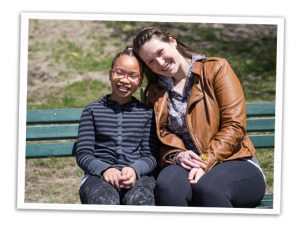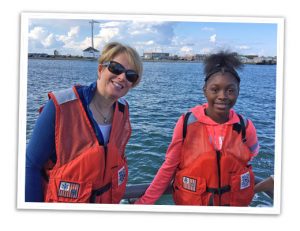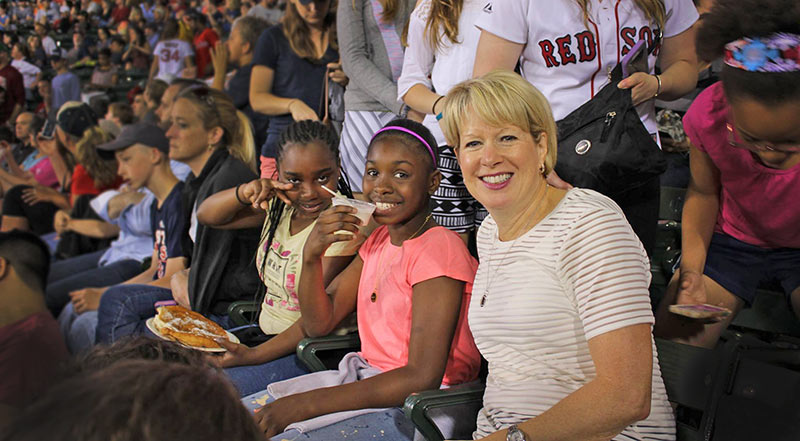Sign up for our monthly Leap Update newsletter and announcements from the Leap Ambassadors Community:
By clicking "Stay Connected" you agree to the Privacy Policy
By clicking "Stay Connected" you agree to the Privacy Policy
Big Brothers, Big Sisters of Massachusetts Bay
How does an organization increase its revenue—to deliver more services—by 62 percent over five years? CEO Wendy Foster shares four key lessons for fundraising capacity, resource investment, board engagement, and cash reserves.
Editor’s Note: From 2013 to 2017, Big Brothers Big Sisters of Massachusetts Bay (BBBSMB) increased its annual revenue by 62 percent, allowing the organization to increase the number of new children paired with a mentor each year by 100 percent and to increase the overall number of children served each year by 54 percent. Here’s a brief explanation of how Wendy Foster, CEO, and her colleagues achieved this audacious goal.
In 2012, Big Brothers Big Sisters of Massachusetts Bay (BBBSMB) leaders were confident their programs were having a transformational impact on children yet wondered: “How do we provide mentors for more children? How do we ensure our sustainability for years to come?” With a modest endowment and cash reserves and a significant percentage of revenue coming from fundraising events which are “transactional, costly, fiercely competitive, and plagued by donor fatigue,” CEO Wendy Foster and her board knew they needed to make some changes.
The fact that we had a detailed plan that focused on sustainability and harnessed the lessons we had learned in past attempts to grow set us apart.
 That’s when Wendy, her leadership team, and board created a five-year plan for expanding the organization’s resources. They focused on moving to 1) a healthy and diverse fundraising platform with no more than 30 percent of revenue coming from events and 2) sustainable growth – refusing to allow annual spending to grow faster than the organization’s ability to confidently increase revenue and not let the quality of services slide (both had happened in the past). She said, “We had to re-convince people that we could deliver, because we had gotten off track with growth before the recession. Our [new] multiyear plan showed exactly what it would take to serve more kids with the greatest outcomes, build the infrastructure to scale, attract new mission-based donors and volunteers, and guide the organization onto a much more sustainable path. The fact that we had a detailed plan that focused on sustainability and harnessed the lessons we had learned in past attempts to grow set us apart. It gave our stakeholders an exciting vision and confidence that their investment would result in more children served over the five years and ensure the organization would help children for many generations to come.”
That’s when Wendy, her leadership team, and board created a five-year plan for expanding the organization’s resources. They focused on moving to 1) a healthy and diverse fundraising platform with no more than 30 percent of revenue coming from events and 2) sustainable growth – refusing to allow annual spending to grow faster than the organization’s ability to confidently increase revenue and not let the quality of services slide (both had happened in the past). She said, “We had to re-convince people that we could deliver, because we had gotten off track with growth before the recession. Our [new] multiyear plan showed exactly what it would take to serve more kids with the greatest outcomes, build the infrastructure to scale, attract new mission-based donors and volunteers, and guide the organization onto a much more sustainable path. The fact that we had a detailed plan that focused on sustainability and harnessed the lessons we had learned in past attempts to grow set us apart. It gave our stakeholders an exciting vision and confidence that their investment would result in more children served over the five years and ensure the organization would help children for many generations to come.”
Achieving the growth goal required disciplined execution. The previous revenue model that relied heavily on special events wasn’t a platform for sustainable growth, so a shift from transactional to relationship-driven fundraising was necessary. Leadership also knew they had to change how they talked to donors, meaningfully engage them in the organization and its strategy, and expand the number of donors. They knew donors needed the chance to ask questions and participate in the change process.
 Staff started by listening to long-time major donors who said they were tired of feeling the pressure to ensure successful events as the primary way to support ever-growing annual operating budgets. They were equally frustrated at the general lack of sustainable growth, the “yo-yoing” between advancing and falling back. Wendy and her team took this feedback to heart. The new strategy included specific fundraising targets over the next five years, additional staff, and number of children served each year. They leveraged lessons learned, provided a framework for how to get stronger, demonstrated a solid understanding of the financial model, and shared their passion and excitement for serving more youth. “Our program gives kids a sense that there is somebody out there who is totally invested in them, who will root for them, and who will help them succeed. That’s a game-changer for under-resourced kids and through this plan we were going to reach more than 3,000 new children,” Wendy said.
Staff started by listening to long-time major donors who said they were tired of feeling the pressure to ensure successful events as the primary way to support ever-growing annual operating budgets. They were equally frustrated at the general lack of sustainable growth, the “yo-yoing” between advancing and falling back. Wendy and her team took this feedback to heart. The new strategy included specific fundraising targets over the next five years, additional staff, and number of children served each year. They leveraged lessons learned, provided a framework for how to get stronger, demonstrated a solid understanding of the financial model, and shared their passion and excitement for serving more youth. “Our program gives kids a sense that there is somebody out there who is totally invested in them, who will root for them, and who will help them succeed. That’s a game-changer for under-resourced kids and through this plan we were going to reach more than 3,000 new children,” Wendy said.
They asked major donors to step up to help make their vision a reality, and they came through with multi-year pledges of more than $8 million over the plan’s five years. Although BBBSMB held the same number of events as previous years, event revenue decreased from 60 percent to 30 percent of the budget, thanks to an increase in individual donations, a shift that put the organization onto a more sustainable path.
As BBBSMB finalized its plan to increase revenue, services, and impact on the community, Wendy and her board made four bold moves, not without controversy.
There is no doubt that making the short-term tradeoff to build fundraising capacity has resulted in our ability to serve thousands more kids in the longer term.
To free up dollars to pay for new development staff and bolster its infrastructure, the organization raised funds that traditionally would have been allocated to programs. Many nonprofits might see this decision as counterproductive to mission, but leadership knew it was important for the long-range plan for sustainability and growth. Although it drew some criticism from staff, the courageous resolve from BBBSMB leaders paid off. Wendy said, “As a leader you are constantly balancing the ‘here and now’ with the future. There is no doubt that making the short-term tradeoff to build fundraising capacity has resulted in our ability to serve thousands more kids in the longer term.”
Wendy and the board decided to hire a “rock star” Chief Development Officer (CDO). They used outside assistance to recruit and hire experienced development talent to execute the strategy. Human service nonprofits regularly lose great development professionals to higher education institutions and hospitals that can afford to pay more. BBBSMB decided it was going to compete on salary requirements to build a top talent team that could change the game for them. The result was a CDO with a higher salary than anyone else at the agency, including the CEO. “The math works because when you invest in high caliber talent, you generate more revenue. Most nonprofits are gun-shy about the initial investment, but if the sector doesn’t get serious about competing for development talent, we won’t get the talent we need to secure the support from donors to make the difference we are being called to make in our communities.”
…when you invest in high caliber talent, you generate more revenue. … if the sector doesn’t get serious about competing for development talent, we won’t get the talent we need to secure the support from donors to make the difference we are being called to make in our communities.
Wendy was looking for a change agent, and she found one! She hired a seasoned professional who had great success raising funds from major donors, as well as a demonstrated ability to build a fundraising team. The CDO’s goals included increasing the number of donors, the total amount of donations, and specific dollar benchmarks; and building a team of individual-giving and major-gift development professionals. This unconventional salary structure required a great deal of time spent convincing leadership staff that this was the right direction. Challenging dialogue and taxing conversations are part of all major change processes.
From the beginning, it was clear that the board of directors had to increase their contributions and identify new donor prospects. The board became accountable for a “give/get” target of $10,000 per year with a rationale that it would take the entire organization—board, donors, and stakeholders—to lift BBBSMB to the next level. (Previously, directors were asked to make BBBSMB one of their top three charities and make a donation that was “meaningful.”)
Wendy and the board took the following steps:
As a result of these changes, some board members left, some rose to the occasion, and new members with a robust contact network joined. The board give/get contributions maintained at 17 percent over the five-year period even as overall revenue grew by 62 percent.
The board set a goal of building a cash surplus into each year’s annual budget. The 2013 budget was crafted so that there would be a $250,000 surplus at the end of the year. Using the same strategy over the next three years resulted in adding more than $1.5 million dollars to BBBSMB’s cash reserves (six months of operating expenses). Close monitoring of revenue and expenses required new levels of discipline, drive, and tenacity. The organization only scaled its programming as revenue increases could sustain the required service infrastructure capacity.
As a result of creating a culture of philanthropy and building a more sustainable revenue stream, leadership achieved additional financial goals, including a competitive salary structure and the ability to award bonuses for specific benchmarks. These targets include the number of children served, quality of programs, and revenue goals. The organization can now demonstrate appreciation and value for high-performing staff monetarily with a bonus pool built into monthly expenses.
BBBSMB recently created a new five-year plan (spanning 2018 to 2022) to grow its current $7 million budget to $10 million and increase the number of youth served by 80 percent. “The organization’s momentum is considerable. In our fiscal year 2018 we will again achieve record-breaking revenue and service targets.” The organization continues to scale growth in parallel to the necessary infrastructure for stability and high-quality services. It’s on a clear path to continued high performance and financial stability.

Interested in increasing your own financial health and sustainability over the long term, like BBBSMB? Then check out Pillar 4 (Financial Health and Sustainability) in the Performance Practice (formerly PIOSA) as a way to spark discussion and begin your own process.
Last Updated: September 26, 2018

Big Brothers, Big Sisters of Massachusetts Bay
Location: Boston, MA
Field: Youth Mentoring
2017 Budget:: $7 million
This document, developed collaboratively by the Leap of Reason Ambassadors Community (LAC), is licensed under a Creative Commons Attribution-NoDerivatives 4.0 International License. We encourage and grant permission for the distribution and reproduction of copies of this material in its entirety (with original attribution). Please refer to the Creative Commons link for license terms for unmodified use of LAC documents.
Because we recognize, however that certain situations call for modified uses (adaptations or derivatives), we offer permissions beyond the scope of this license (the “CC Plus Permissions”). The CC Plus Permissions are defined as follows:
You may adapt or make derivatives (e.g., remixes, excerpts, or translations) of this document, so long as they do not, in the reasonable discretion of the Leap of Reason Ambassadors Community, alter or misconstrue the document’s meaning or intent. The adapted or derivative work is to be licensed under a Creative Commons Attribution-NoDerivatives 4.0 International License, conveyed at no cost (or the cost of reproduction,) and used in a manner consistent with the purpose of the Leap of Reason Ambassadors Community, with the integrity and quality of the original material to be maintained, and its use to not adversely reflect on the reputation of the Leap of Reason Ambassadors Community.
Attribution is to be in the following formats:
“From ‘Performance in Action: Big Brothers Big Sisters of Massachusetts Bay, “Four Bold Moves”,’ developed collaboratively by the Leap of Reason Ambassadors Community, licensed under CC BY ND https://creativecommons.org/licenses/by-nd/4.0/. For more information or to view the original product, visit https://leapambassadors.org/performance-articles/four-bold-moves/.”
The above is consistent with Creative Commons License restrictions that require “appropriate credit” be required and the “name of the creator and attribution parties, a copyright notice, a license notice, a disclaimer notice and a link to the original material” be included.
The Leap of Reason Ambassadors Community may revoke the additional permissions described above at any time. For questions about copyright issues or special requests for use beyond the scope of this license, please email us at info@leapambassadors.org.
We use cookies for a number of reasons, such as keeping our site reliable and secure, personalising content and providing social media features and to analyse how our site is used.
Accept & Continue